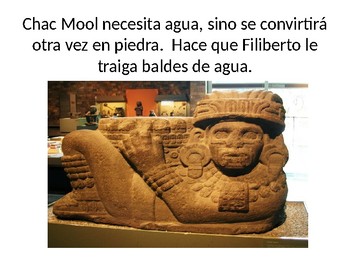
The Chac Mool altars also served for human sacrifices: some had cuauhxicallis, or special recipients for the blood of sacrificial victims, while others had special téhcatl altars where humans were ritualistically sacrificed. These offering could consist of anything from foodstuffs like tamales or tortillas to colorful feathers, tobacco or flowers.

The purpose of the Chac Mools was generally as a place for sacrificial offerings for the gods. Lo fantastico en un cuento de Carlos Fuentes : análisis de Chac Mool.

Topic 7: Celebrations How do different cultures recognize major rites of passage Magazine article: Las piatas. It is never found in the back, where something revered as a deity would be expected to rest. Short story: Chac Mool by Carlos Fuentes. Una noche descubre que el Chac Mool estaba vivo como él sospechaba y esto le fascina al principio, pero después se vuelve su prisionero. Un día decide limpiara Chac Mool y nota cómo en lugar de piedra parece empezar a estar blando, como hecho de tejido vivo. When located in temples, the Chac Mool is nearly always positioned between the spaces associated with the priests and that associated with the people. A los pocos días llueve y el sótano se le vuelve a llenar de agua. The statues had a utilitarian purpose and were not, in themselves, worshiped: this is known because of their relative positions within the temples. Desde esta perspectiva, en el presente texto abordo una serie de interpretaciones sobre algunos tejidos e imgenes simblicas en el cuento del escritor mejicano Carlos Fuentes El Chac Mool dichas imgenes estn referidas a los elementos naturales: agua, tierra, fuego, aire y a los elementos objetuales. creencias folclricas recuerda al Chac Mool del mexicano Carlos Fuentes y al. Además, se conocen otras piezas procedentes de Ihuatzio, Quiriguá, Cempoala y el Templo Mayor de México-Tenochtitlan, entre otros.The statues - some of which are quite elaborate - obviously had an important religious and ceremonial uses for the different cultures that created them. anlisis mostrar que la imposibilidad de realizar dicha empresa se puede. Varios ejemplares se han encontrado en Tollan-Xicocotitlan y Chichén Itzá, este hecho es uno de los argumentos utilizados en los debates sobre las relaciones entre estos dos sitios. Carlos Fuentes video El espejo enterrado- Program III- La Edad de Oro. Este tipo de estatuas hizo su aparición en Mesoamérica al inicio del posclásico, y es asociada a los toltecas. 3-Poem analysis practice to help students recognize literary language and. No debe confundirse con Chaac, dios maya de la lluvia. El nombre significa "gran jaguar rojo" y se ha vuelto usual y se mantiene por ello su utilización por los arqueólogos. Chac Mool es una obra literaria que usa el realismo magico para communicar el tradicion entre las culturas. oneisevernamed charactersaresimply'elhombre,''ladivorciada,' 'elcarpintero'and'laniña.'Neitherdoestheblackpantherappearand thereadersoonbeginstoquestion animal. Fuentes fue mas que un autor, tambien fue un membrio del 'Boom'.

El término fue acuñado en 1875 por el explorador Augustus Le Plongeon, quien observó este tipo de esculturas por primera vez en Yucatán, por ello propuso un nombre en maya yucateco. Chac Mool el cuento escrito por el autor mexicano, Carlos Fuentes es una obra literaria que incluye los dos intereses de el, la fantasía y los mitos Mexicanos. Chac mool es un tipo de esculturas precolombinas mesoamericanas que aparecen al principio del Período Posclásico en diversos sitios de la región. In addition, other pieces are known from Ihuatzio, Quiriguá, Cempoala and the Templo Mayor of Mexico-Tenochtitlan, among others. in 1954 by Los Presentes publishing house. Several specimens have been found in Tollan-Xicocotitlan and Chichén Itzá, this fact is one of the arguments used in the debates on the relations between these two sites. This article presents an analysis of the configuration of time and space in the short story Chac Mool by the Mexican writer Carlos Fuentes (1928-2012), published in the volume of short stories. This type of statues made their appearance in Mesoamerica at the beginning of postclassic, and is associated with the Toltecs. literary criticism and to allow them to refine their skills in the analysis of texts. Not to be confused with Chaac, Mayan god of rain.

The name means "great red jaguar" and has become usual and is therefore used by archaeologists. The term was coined in 1875 by the explorer Augustus Le Plongeon, who observed this type of sculptures for the first time in Yucatán, for that reason it proposed a name in Mayan Yucateco. Chac mool Chac mool is a type of pre-Columbian Mesoamerican sculptures that appear at the beginning of the Postclassic Period in diverse places of the region.


 0 kommentar(er)
0 kommentar(er)
